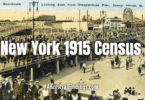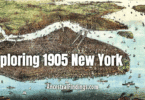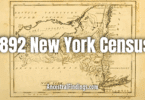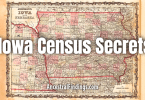The 1930 U.S. Census captures America in an unsettled moment. The Roaring Twenties were winding down, but the Great Depression was just beginning to take hold. It’s a census taken in the calm before the storm fully broke. A generation that had just emerged from the trauma of World War I and the 1918 flu pandemic found itself navigating economic boom—and, soon after, one of the most devastating financial collapses in history.
This makes the 1930 census especially valuable to genealogists and family historians. It not only shows us where people were and what they were doing, but it offers a final snapshot of prosperity for some, and for others, early signs of hardship. When read alongside the 1920 census, it helps us ask important questions: Did families move in search of work? Were more people renting than owning? Did younger generations start their adult lives in very different ways from their parents?
It’s also a census that teeters between old and new. Traditional jobs and family structures still dominated, but you can see modern America coming into view, especially in cities. With the next census in 1940 capturing a nation preparing for war, the 1930 census stands as a middle chapter in a story of massive change.
What Was Going On in 1930?
When census takers went door to door in April 1930, the U.S. population had just surpassed 122 million. The stock market crash had occurred only six months earlier, in October 1929. At the time of enumeration, people didn’t yet know just how deep and long the Great Depression would be. Most still hoped it was temporary.
Culturally, America had entered the era of jazz, radio, and Hollywood films. Prohibition was still in effect, and organized crime had surged as a result. Many Americans, especially in urban areas, were embracing new forms of entertainment and social behavior that would have seemed radical only a decade earlier. The automobile was changing the way people lived and worked. Electricity and indoor plumbing were becoming more common, though rural areas often lagged behind.
The effects of these changes are not directly recorded in the census, but you can sense them when you study the records closely. Occupations shifted, households formed differently, and more people lived in cities than ever before. This census lets you see a nation straddling two very different identities: one rooted in the 19th century and one stepping cautiously into the 20th.
What Was Asked in the 1930 Census?
This census expanded on many questions from 1920 and reintroduced some older ones that had been left out previously. Here’s what you’ll find:
- Name, relationship to head of household, sex, race, age, marital status, and age at first marriage.
- Whether the person attended school or was able to read and write.
- Place of birth of the person and their parents.
- Year of immigration to the U.S., whether naturalized, and the ability to speak English.
- Occupation, industry, and class of worker (wage or salary, own business, or unpaid family worker).
- Employment status: whether the person was at work the previous day or unemployed.
- Homeownership status: owned or rented, value of the home or monthly rent, and whether the family owned a radio set.
- For veterans: whether the person was a veteran of U.S. military or naval forces, and what war or expedition they served in.
The question about radio ownership is unique to the 1930 census. It’s a small detail, but it offers insight into which families had access to national news, entertainment, and culture in real time—a window into the growing influence of mass media.
Research Tips for Using the 1930 Census
The 1930 census is a useful benchmark. If someone appears here but not in 1940, this could help you narrow down a date of death. If a family moved between 1920 and 1930, this record may help you pinpoint when and why.
Watch for family changes. Who got married? Who moved out? You may find grown children from the 1920 census starting their own households, often nearby. You might also see families doubling up as the economic downturn began—siblings living together, in-laws under one roof, or older parents moving back in with adult children.
Take note of employment. The occupation and industry listings give clues about both stability and upheaval. A family with three working adults in 1930 may be surviving better than a single breadwinner household. If someone was listed as unemployed, that might prompt a deeper look into local economic conditions.
Homeownership is another telling feature. Compare it to 1920—did your ancestors go from owning to renting? From farm to town? These changes often align with personal losses or broader economic forces.
Veteran information can help identify Civil War, Spanish-American War, and World War I service. That might open the door to military pensions, draft cards, or service files you haven’t checked yet.
Historical Clues Not Written in Ink
Though the census doesn’t mention it, 1930 was a turning point in African American migration. The Great Migration was underway, with Black families moving from the South to Northern cities in search of opportunity and safety. This shift often appears in the form of new addresses in Detroit, Chicago, Pittsburgh, and other industrial centers.
Women’s roles were changing, too. While the census still generally lists men as heads of household, you’ll begin to see more single women working as teachers, nurses, secretaries, and clerks. Some are listed as heads of household in their own right, reflecting changing norms.
The census also caught families on the brink of displacement. For example, if someone is listed as a farmer in 1930 in Oklahoma or Texas, they may have faced the Dust Bowl within a few years—something to watch for in the 1940 census.
Why the 1930 Census Matters
The 1930 census provides a powerful middle chapter. It helps connect dots between the older generation of immigrants and their American-born children. It captures a society just before it had to adapt quickly to massive challenges. And it documents small moments that help us understand the bigger picture.
Use it to explore how your ancestors weathered changing times. Ask what they might have been feeling, what they could see ahead, and what they couldn’t. Then follow their story into the 1940 census to see how they endured, adapted, or disappeared from the record altogether.
That’s the story the 1930 census helps you tell—one of transition, uncertainty, and quiet strength.






